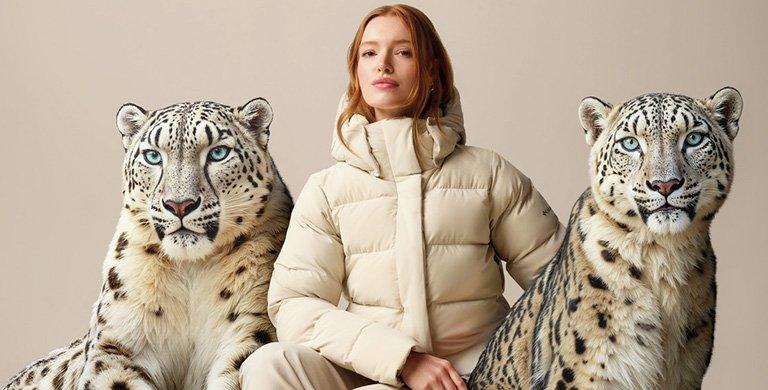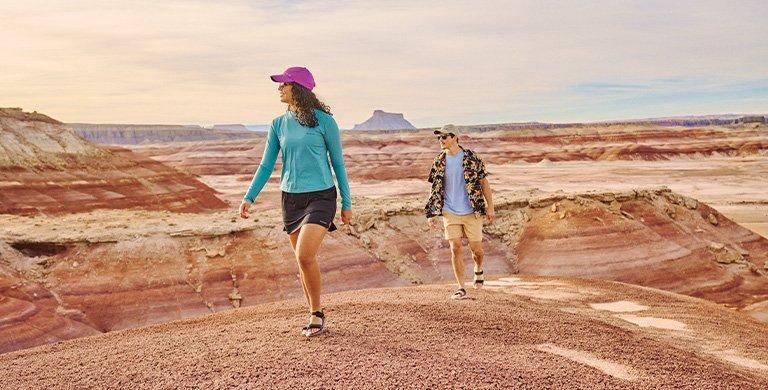TECHNOLOGY
Gear Guide:
The "One Jacket" Vacation
BY NATHAN DINSDALE
The good news? You're leaving the day-to-day behind to seek outdoor adventure an airplane flight (or three) away from home. That's right, it's vacation time. The catch? You only have room to bring one jacket. Here are some tips for choosing wisely.
Know before you go
You get one choice, so make it count. Otherwise you may end up lugging around a jacket you can't really use on its own vacation from the closet. A few things to consider in advance:
- Destination. Whether you're expecting to spend the bulk of your time on snow, sand, or sidewalks, wherever you're going will give you a good idea about what to bring.
- Weather. Check the extended forecast at your destination starting from the day of your departure. This will provide an educated guess about what to expect on the ground.
- Activity. Going skiing, hiking, or general sight-seeing? What you plan to do on your vacation will dictate the jacket you do it in.
- Weight. The general rule of travel is the lighter the better. Easier if you're headed to a warmer locale, more challenging if you're preparing for a colder environment. The plus side is that your jacket doesn't count as carry-on if you bring it with you in transit.
Bring on the elements
You want a do-it-all jacket for whatever you're going to do, wherever you're going to be. The critical factor is to have a layer that will keep you comfortable for the conditions you're most likely to encounter.
Cold
Heading up to the mountains or just visiting a winter wonderland, arguably the most challenging one-jacket vacation is the cold-weather destination. Two primary options:
The puffer jacket: Light in weight (and thus highly packable) yet heavy in cold-fighting power, a puffy is the warm hug you give yourself in frigid conditions. It uses a quilted design filled with natural or synthetic down. The higher the "fill" (generally from 300-fill to 800+), the warmer it'll be. But while puffers are built for the cold, they're less ideal for wet or rainy conditions.
The snow jacket. If the puffer is made for window-shopping in a resort town, the snow jacket is built for being on the mountain. Whether you're skiing, snowboarding, snowshoeing, or something in between, it's made for protection and performance in volatile conditions. It's typically waterproof, insulated, and feature-rich with a hood, pockets, zip vents, and more.
Heading up to the mountains or just visiting a winter wonderland, arguably the most challenging one-jacket vacation is the cold-weather destination. Two primary options:
The puffer jacket: Light in weight (and thus highly packable) yet heavy in cold-fighting power, a puffy is the warm hug you give yourself in frigid conditions. It uses a quilted design filled with natural or synthetic down. The higher the "fill" (generally from 300-fill to 800+), the warmer it'll be. But while puffers are built for the cold, they're less ideal for wet or rainy conditions.
The snow jacket. If the puffer is made for window-shopping in a resort town, the snow jacket is built for being on the mountain. Whether you're skiing, snowboarding, snowshoeing, or something in between, it's made for protection and performance in volatile conditions. It's typically waterproof, insulated, and feature-rich with a hood, pockets, zip vents, and more.
Bonus warmth. One way to add comfort without extra bulk is to get a jacket with a thermal-reflective lining that helps reflect and retain body heat to deliver lightweight warmth.
Wet
Venturing to a rain forest or just preparing for a typical day in the Pacific Northwest, your goal is to keep your vacation mood high by staying dry. Two primary options:
The shell. When you want maximum versatility and protection with minimal weight, the shell jacket is your go-to layer. Its main purpose is to do just that—keep the elements out—with waterproof, seam-sealed fabric designed to weather the storm in comfort. Its primary use is as a first line of defense while your layers underneath deliver warmth as needed.
The parka. Often used as a ubiquitous term for any jacket that will provide reasonable comfort and protection in volatile weather, one distinguishing factor is that a parka generally has a longer hemline for added coverage. In this case, a rain parka is typically waterproof, hooded, and could feature down or synthetic insulation for added warmth.
Venturing to a rain forest or just preparing for a typical day in the Pacific Northwest, your goal is to keep your vacation mood high by staying dry. Two primary options:
The shell. When you want maximum versatility and protection with minimal weight, the shell jacket is your go-to layer. Its main purpose is to do just that—keep the elements out—with waterproof, seam-sealed fabric designed to weather the storm in comfort. Its primary use is as a first line of defense while your layers underneath deliver warmth as needed.
The parka. Often used as a ubiquitous term for any jacket that will provide reasonable comfort and protection in volatile weather, one distinguishing factor is that a parka generally has a longer hemline for added coverage. In this case, a rain parka is typically waterproof, hooded, and could feature down or synthetic insulation for added warmth.
Waterproof vs Water-resistant. The difference is how well a jacket stands up to the severity and duration of wet conditions. Water-resistant will shrug off light drizzle to moderate rain in limited bursts. A critically seam-sealed waterproof jacket will hold up longer in more severe conditions, though may be susceptible to prolonged exposure. A fully seam-sealed waterproof jacket is built to take on whatever the sky throws at it.
Warm
You're en route to palm trees and sandy beaches or dry desert climates with plenty of sunshine. But just because you're headed to "Wish You Were Here" postcard destinations doesn't mean you don't need a jacket when the sun comes up or goes down. Two primary options:
The windbreaker: Lightweight yet capable of providing comfort when the weather takes a turn. Typically made of nylon or similar fabric, this highly packable layer is usually thin while still providing protection should a stiff wind pick up or some light rain fall.
The performance fleece. Soft, stretchy and built for active comfort, a lightweight fleece jacket is made for a higher-altitude hike in otherwise warm climates or the perfect layer for added warmth to soak in an early morning sunrise or an after-dark beach bonfire.
You're en route to palm trees and sandy beaches or dry desert climates with plenty of sunshine. But just because you're headed to "Wish You Were Here" postcard destinations doesn't mean you don't need a jacket when the sun comes up or goes down. Two primary options:
The windbreaker: Lightweight yet capable of providing comfort when the weather takes a turn. Typically made of nylon or similar fabric, this highly packable layer is usually thin while still providing protection should a stiff wind pick up or some light rain fall.
The performance fleece. Soft, stretchy and built for active comfort, a lightweight fleece jacket is made for a higher-altitude hike in otherwise warm climates or the perfect layer for added warmth to soak in an early morning sunrise or an after-dark beach bonfire.
Cheat the system. An end-around the "one-jacket" rule is to buy a 3-in-1 jacket with two layers—typically a waterproof shell and an insulated liner—that can be worn separately or zipped together for maximum versatility and comfort.
Going on a trip? Or just to the store? Explore our jackets.
Want more outdoors? Connect with @Columbia1938 on Instagram.



